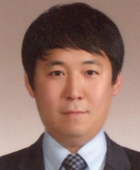
이방성 항복함수를 고려한 구조 성형해석에서 마찰계수 결정
Abstract
This paper discusses a method to determine the friction coefficient between molds and a sheet material during metal-forming processes. A deep-drawing process with a hemispherical punch was performed with a 99.9% pure copper ultra-thin sheet material (0.15 mm thick). Tensile tests were conducted along three specimen orientations to determine the material properties for use in finite element (FE) simulations. Different calibration methods for an anisotropic yield function (Hill48) were examined to describe the yield and r-value behaviors. FE simulations with different friction coefficients and constitutive equations were performed to confirm the variation in force vs. displacement response and major/minor strain fields. To determine the friction coefficient, an optimization process was conducted to minimize the differences between the FE and experimental results, which showed good agreement when the optimized friction coefficient was applied. The proposed method would be useful for generating precise FE models for sheet-metal-forming processes.
Keywords:
Friction coefficient, Forming analysis, Anisotropic yield criteria, Finite element method, Ultra-thin copper sheetAcknowledgments
이 연구는 한국생산기술연구원 내부연구과제(과제번호: KITECHJE-23-0017)의 지원을 받아 수행되었습니다.
References
-
Singh, A., Basak, S., PS, L. P., Roy, G. G., Jha, M. N., Mascarenhas, M., Panda, S. K., 2018, Prediction of Earing Defect and Deep Drawing Behavior of Commercially Pure Titanium Sheets using CPB06 Anisotropy Yield Theory, J. Manuf. Process., 33 256-267.
[https://doi.org/10.1016/j.jmapro.2018.05.003]

-
Tisza, M., 2004, Numerical Modelling and Simulation in Sheet Metal Forming, J. Mater. Process. Tech., 151:1-3 58-62.
[https://doi.org/10.1016/j.jmatprotec.2004.04.009]

-
Lou, Y., Zhang, S., Yoon, J. W., 2019, A Reduced Yld2004 Function for Modeling of Anisotropic Plastic Deformation of Metals Under Triaxial Loading, Int. J. Mech. Sci., 161-162 105027.
[https://doi.org/10.1016/j.ijmecsci.2019.105027]

-
Chen, J., Wang, Z., Chu, X., Yue, Z., Zhao, C., Zhou, Y., 2023, Calibration of Yld2000-2D Anisotropy Yield Criterion with Traditional Testing and Inverse Identification Strategies, Materials, 16:21 6904.
[https://doi.org/10.3390/ma16216904]

-
Pham, Q. T., Lee, B. H., Park, K. C., Kim, Y. S., 2018, Influence of the Post-necking Prediction of Hardening Law on the Theoretical Forming Limit Curve of Aluminium Sheets, Int. J. Mech. Sci., 140 521-536.
[https://doi.org/10.1016/j.ijmecsci.2018.02.040]

-
Chen, K., Breunig, A., Ha, J., Kinsey, B. L., Groche, P., Korkolis, Y. P., 2022, Robustness of Deep-drawing Finite-element Simulations to Process Variations, Int. J. Mater. Form., 15:3 45.
[https://doi.org/10.1007/s12289-022-01695-3]

-
Kim, M., Chen, K., Carriere, P., Matavalam, N., Penney, J., Kutsaev, S., Korkolis, Y. P., 2022, Mechanical Behavior and Forming of Commercially-pure Niobium Sheet, Int. J. Solids Struct., 257 111770.
[https://doi.org/10.1016/j.ijsolstr.2022.111770]

-
Dou, S., Xia, J., 2019, Analysis of Sheet Metal Forming (stamping process): A Study of the Variable Friction Coefficient on 5052 Aluminum Alloy, Metals, 9:8 853.
[https://doi.org/10.3390/met9080853]

-
Xia, J., Zhao, J., Dou, S., 2022, A Novel Model Developed for Frictional Characteristics Analysis of Axial Symmetric Parts, Symmetry, 14:5 842.
[https://doi.org/10.3390/sym14050842]

- Lankford, W. T., Synder, S. C., Bausher, J. A., 1950, New Criteria for Predicting the Performance of Deep Drawing Sheets, Transactions of American Society for Metals, 42 1197-1232.
-
Ramos, G. C., Stout, M., Bolmaro, R. E., Signorelli, J. W., Turner, P., 2010, Study of a Drawing-quality Sheet Steel. I: Stress/Strain Behaviors and Lankford Coefficients by Experiments and Micromechanical Simulations, Int. J. Solids Struct., 47:17 2285-2293.
[https://doi.org/10.1016/j.ijsolstr.2010.04.023]

-
Swift, H. W., 1952, Plastic Instability under Plane Stress, J. Mech. Phys. Solids, 1:1 1-18.
[https://doi.org/10.1016/0022-5096(52)90002-1]

- Voce, E., 1948, The Relationship between Stress and Strain for Homogeneous Deformation, J. Inst. Met. 74 537-562.
-
Shah, H., Rajagopal, P., Balasubramaniam, K., 2017, Guided Waves for Online Monitoring of Composites, AIP Conf. Proc., 1806:1 030013.
[https://doi.org/10.1063/1.4974581]

-
Mamros, E. M., Mayer, S. M., Banerjee, D. K., Iadicola, M. A., Kinsey, B. L., Ha, J., 2022, Plastic Anisotropy Evolution of SS316L and Modeling for Novel Cruciform Specimen, Int. J. Mech. Sci., 234 107663.
[https://doi.org/10.1016/j.ijmecsci.2022.107663]

-
Yan, Y., Wang, H., Li, Q., 2015, The Inverse Parameter Identification of Hill 48 Yield Criterion and Its Verification in Press Bending and Roll Forming Process Simulations, J. Manuf. Process., 20 46-53.
[https://doi.org/10.1016/j.jmapro.2015.09.009]

-
Qian, L. Y., Fang, G., Zeng, P., 2017, Modeling of the Ductile Fracture during the Sheet Forming of Aluminum Alloy Considering Non-associated Constitutive Characteristic, Int. J. Mech. Sci., 126 55-66.
[https://doi.org/10.1016/j.ijmecsci.2017.03.013]

-
Huh, J., Huh, H., Lee, C. S., 2013, Effect of Strain Rate on Plastic Anisotropy of Advanced High Strength Steel Sheets, Int. J. Plast., 44 23-46.
[https://doi.org/10.1016/j.ijplas.2012.11.012]

-
Zhang, Z. H., Li, W. Y., Feng, Y., Li, J. L., Chao, Y. J., 2015, Global Anisotropic Response of Friction Stir Welded 2024 Aluminum Sheets, Acta Mater., 92 117-125.
[https://doi.org/10.1016/j.actamat.2015.03.054]

-
Hill, R., 1948, A Theory of the Yielding and Plastic Flow of Anisotropic Metals, Proc. R. Soc. A-Math. Phys. Eng. Sci., 193:1033 281-297.
[https://doi.org/10.1098/rspa.1948.0045]

-
Mu, Z., Zhao, J., Meng, Q., Zhang, Y., Yu, G., 2022, Limitation Analysis of the Hill48 Yield Model and Establishment of its Modified Model for Planar Plastic Anisotropy, J. Mater. Proc. Technol., 299 117380.
[https://doi.org/10.1016/j.jmatprotec.2021.117380]


Graduate Student in the Department of Mechanical Engineering, Inha University and Researcher in Korea Institute of Industrial Technology. His research interest is Metal Forming.
E-mail: kbh960625@kitech.re.kr

Graduate Student in the Department of Mechanical Engineering, Inha University and Researcher in Korea Institute of Industrial Technology. His research interest is Metal Forming.
E-mail: yb_kim@kitech.re.kr

Principal Researcher (Ph. D.) in Korea Institute of Industrial Technology. His research interest is Metal Forming.
E-mail: sslim@kitech.re.kr

Senior Researcher (Ph. D.) in Korea Institute of Industrial Technology. His research interest is Plasticity, Material Testing & Modeling, Experimental Mechanics.
E-mail: mkim@kitech.re.kr